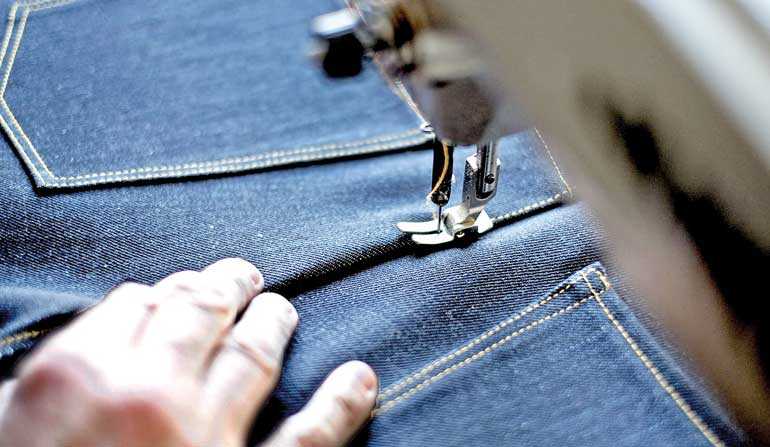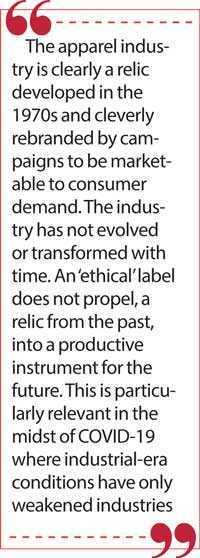Monday Dec 29, 2025
Monday Dec 29, 2025
Tuesday, 3 November 2020 00:35 - - {{hitsCtrl.values.hits}}

Sri Lanka’s ‘ethical’ promise is a thin façade with limited transparency, accuracy and reliability
By Devana Senanayake and Janik Sittampalam
“When workers fainted, they just sprinkled water on their faces and got them to work again. They were allowed only a five-minute break. If not, a message was sent requesting them to report back to work,” said R. Rathnayake, the 39-year-old worker from ‘Minuwangoda cluster’ who first tested positive for COVID-19.
Despite the persistence of symptoms, she was treated by in-house medical care, asked to return to work and was only sent to the hospital when her condition worsened. While the hospital had conducted a PCR test, they had sent her home before they had received her results. She only found out that she had been infected when an intelligence officer who visited her house informed her. Over the next couple of days, the worker’s daughter, factory workers and their contacts tested positive.
When the first wave of COVID-19 broke out, production stopped under the nationwide lockdown. The industry faced reduced orders from retailers in Europe, the US and the UK. Companies such as the ‘notorious’ Hirdaramani responded with job cuts, wage cuts, elimination of allowances, increased work hours and higher productivity targets.
These exploitative conditions need to be considered in light of the COVID-19 outbreak. Can workers continue to work in these exploitative environments? Should companies retain the risk of unsustainable practices which have proven to be fallible in the midst of a public health crisis?
As Judith Shaw said, the question is if a country should “take the ‘low road’ of price competitiveness based on low labour costs, or the ‘high road’ of quality-based competitiveness [which] has important implications for job quality?”
 |
 |
 |
History of apparel industry in Sri Lanka
In 1977, Sri Lanka adopted market-oriented policy reforms and set up FTZs (Free Trade Zones). These FTZs presented an attractive package for investors which included an educated and cheap labour pool, many of which consisted of women from rural areas who were ‘pushed’ rather than ‘pulled’ into employment because of poverty and limited opportunity.
A total of 62% joined FTZs to contribute to their household income, through remittances. Sri Lanka “marketed the ‘nimble fingers’ of young women as an economic asset and as a ‘comparative advantage’ in a competitive labour market,” said Swarna Jayaweera.
In 1985, FTZs employed 24,000 women who made up 90% of the labour force. In 1994, FTZs expanded—Katunayake had 92 enterprises, Biyagama had 38 enterprises and Koggala had 11 enterprises. In 2020, the 12 FTZ zones and industrial parks in the country employ 300,000 formal workers and 600,000 informal workers. The IPS (Institute of Policy Studies) believes that 78-87% of these workers are women.
Apart from employment, the apparel industry produced 28.8% of Sri Lanka’s total exports as reported by the Central Bank, boosted foreign currency earnings and made “a positive economic contribution as part of an export diversification strategy” (as advised by K. Jayanthakumaran).
Workers exploited
Competitive production is steeped in exploitative practices in Sri Lanka. Worker contracts violate labour laws; and human, civil and constitutional rights.
“These terms, influenced by capitalist and patriarchal constraints, display the prevailing attitudes among both Government officials and factory managers that women should be grateful for their jobs, whatever their working conditions were,” said Sandya Hewamanne about an industry which reduced workers to the productivity of their ‘nimble fingers’.
A qualitative study conducted by Judith Shaw in 2007, revealed that 70% of workers reported dissatisfaction with their job and 86% reported a desire to return to their homes if a local job became available.
In 2018, the Department of Labour’s Wages Boards for the Garments Manufacturing Trade revealed that worker salaries were dismally low. Workers were paid on a combination of ‘Grades’ (based on skill) and ‘Years’ (based on experience). A ‘Grade V with 1 year of experience’ employee was paid 7,500 per month and a ‘Grade 1A with 5 years of experience’ employee was paid 15,400 per month. These wages do not adequately cover even basic expenses such as accommodation, food, clothes and transport in the country.
Workers also have poor relationships with management. Supervisors “used foul language and physical force (pushing, squeezing, light slapping),” Hewamanne observed in her study. These factories had an authoritative management style and a strict chain of command, which could easily turn abusive. Indeed, two-thirds of workers complained of verbal abuse and 14% complained of physical abuse.
They also had to complete ‘overtime’ work (“Many workers felt that they were being treated as if they were machines not humans with physical limits”) and had to meet production targets which were set at “unachievable levels” to prevent payment.
Unmet targets were met with punishment in the form of public humiliation (such as the placement of ‘black flags’ on work tables) or the allocation of menial tasks (such as cleaning toilets). Hewamanne described the “humiliation coupled with discomfort [which] seemed to spur the workers to meet the target at any cost, which sometimes required forfeiting their tea or lunch break”.
These women also lived in poor accommodation. Makeshift houses which failed to meet basic regulatory standards were hastily built in the 1980s to profit from the influx of workers into local areas. These houses were overcrowded as workers shared rooms, kitchens and toilets.
Women also face gender based violence on public transport, where, two-thirds experienced sexual harassment while travelling to work.
While Shaw and Hewamanne conducted their research in the mid-late 2000s, many of the observations continue to remain intact. An unnamed source from Sri Lanka’s ‘notorious’ Hirdaramani factories described her circumstances:
“All the workers are now only paid the basic salary. In the name of making up for ‘lost time,’ they have to work an extra hour per day but with no additional pay. All allowances, including the attendance allowance have been cut and the New Year bonus was not paid.”
Exploitative conditions, unsafe practices and limited attention to health resulted in the ‘Minuwangoda’ cluster. “I had a fever. I even fainted at work. But they did not care about us….I learned later that a senior officer had scolded and criticised me for being hospitalised for chest pains, claiming there were shipments pending,” R. Rathnayake confided in Daily Mirror. Workers cannot continue to work if these exploitative conditions continue and companies cannot retain these subpar standards with the risks they pose to production.
Should the industry have a more ‘ethical’ focus?
The combined pressure of trade unions and ‘ethical’ demand from international consumers pushed Sri Lanka, in the early 2000s to adopt an ‘ethical’ marketing strategy. In 2002, the Joint Apparel Association Forum ran the ‘Garments Without Guilt’ campaign to promote Sri Lanka as an ‘ethical’ destination.
“[The] Sri Lankan apparel industry as an ‘ethical’ supplier takes global governance regimes seriously—an image that the industry has strategically cultivated,” Kanchana Ruwanpura noted.
The industry is certainly strategic as recent campaigns such as the ‘Green Garment Factory’ take environmental impact into account but do not touch on the workers themselves.
The positive press is also tied to Sri Lanka’s high indices for health rooted in the country’s universal healthcare coverage. However, these national indices do not hone in on the impact of work on the worker’s health or chronic conditions borne out of an exploitative environment. Many reported work-related illnesses or injuries: 30% had soreness from long hours of standing, 14%, had minor injuries (such as needle pricks) and 10% had chronic respiratory conditions.
Another reason for the limited ‘international’ press is the lack of child labour or forced labour—many of the workers are women who have completed eight to 12 years of education.
The terminology for marketing ethical products are inconsistent and unclear. Companies such as MAS describe their factories as ‘ethical’ but there are limited details of what constitutes these practices. Louise Hassan’s study examined the ‘ethical’ label from a consumer’s standpoint. One consumer said that it is “not particularly obvious in the high street whether things are ethical or not, you have no way of knowing really.”
While Fidelity Manufacturing lists their ‘ethical’ policies, there is a limited focus on the enforcement of these practices. The absence of a national audit which analyses the ‘ethical’ label, means that it is impossible to quantify or check the quality of the label. Moreover, as there is an absence of data, is it impossible to accurately discover Sri Lanka’s position on an ‘ethical spectrum’ and devise methods to become more ‘ethical’.
Ruwanpura’s research recounted the story of a Karthika, who was employed as a multi-skilled worker, a ‘jumper’, on the production line of an ‘ethical’ factory.
Each production line had a First Aid Cross, with colours marked out to capture the scale of the incident. When Karthika had an injury which resulted in non-stop bleeding, she was provided with in-house medical care. When this failed, an HR officer, Nurse and a Junior Manager took Karthika to the hospital. The First Aid Cross was not marked and no accident was recorded
“Sister, they never make note of such accidents. If they think they are at fault, they will offer all the medical attention,” a worker informed Ruwanpura.
When Karthika returned to work, HR informed her that she had no entitlement to paid medical leave and her time at the hospital had been allocated as no-pay leave.
“Under the guise of the organisational fix of ethical governance, management is then not without shrewd armoury that continually finds ways to constrain the welfare of workers when it affects their profit margin—and hence labourers’ agency is suppressed,” Ruwanpura noted.
Sri Lanka’s ‘ethical’ promise is a thin façade with limited transparency, accuracy and reliability.
Cleverly branded ‘ethical’ campaigns are just another route for factories to be ‘competitive’ with no structural change or accountability. Indeed, in Sri Lanka, exploitative undercurrents fuel ‘ethical’ production.
What should Sri Lanka do?
The apparel industry is clearly a relic developed in the 1970s and cleverly rebranded by campaigns to be marketable to consumer demand. The industry has not evolved or transformed with time. An ‘ethical’ label does not propel, a relic from the past, into a productive instrument for the future. This is particularly relevant in the midst of COVID-19 where industrial-era conditions have only weakened industries.
In his article for Groundviews, Vidura Munasinghe stated that South Korea and Taiwan moved away from the strategy of manufacturing enclaves because they saw through its promise of export earnings which “exploit[ed] the labour and land resources of a country.”
South Korea and Taiwan established their FTZz in the 1960s and focused on labour-intensive industries, such as textiles. From the 1960-1990s, both countries transformed their FTZs from labour-intensive to capital-intensive industries, which they then pushed a step further to become high-tech industries.
In the late 1990s, Taiwan transformed their zones into storage and logistics hubs to supplement and boost local industries. In the 2000s, Korea set up Free Economic Zones which were not closed industrial parks, but areas with incentives for financial firms, research and development projects and logistics. These zones had public services such as “cutting-edge airports, ports, and office facilities as well as first-rate schools, hospitals, financial services, malls, leisure services, and tourist facilities,” wrote Aaradhna Aggarwal.
While both South Korea and Taiwan used the FTZ model, they pushed the models beyond their dependence on the textile industry. They incorporated other industries which had a better moral stance and higher return. Their hubs were multipurpose and acted as a destination for a range of services. Unlike Sri Lankan FTZs, the South Korean and Taiwanese models are responsive to the global economy and evolve with it too.